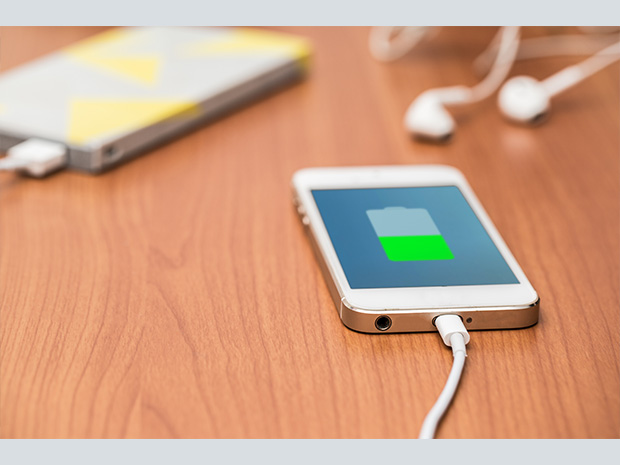A Flash Battery that charges your phone in a minute, is made out of organic compounds that help protect the environment and can also charge an electric car? Yes, please.
No matter where you fall in the debate surrounding the pros and cons of technology, there’s no question that the growth of technology in the last decades has been astounding. From dial-up internet on a clunky desktop to email accessible in the palms of our hands, we have witnessed an indisputable revolution brought about by countless breakthroughs, advancements, and inventions.
Smartphones, smartwatches, laptops, electric vehicles … They’re all new, they’re all exciting, and they all have technological advances being developed every day. However, most devices today are at the mercy of lithium-ion batteries, that can’t keep up with our usage. The lack of actual headway in developing new advancements to the power source of these products has prevented a full-fledged technological uprising. Until now.
Breakthroughs have been made that suggest it’s possible to use friction to harness power from your skin, transmit energy through sound waves, produce power from water dew in the air, create radio waves that send out power rather than just data, power batteries using urine, charge phones from ambient sound in the atmosphere, replace the lithium in batteries with sodium, run batteries on hydrogen fuel, develop a paper-like and water-proof foldable battery, and reduce the size of a battery to a nanobattery which is less than a strand of human hair.
With so much hinging on the betterment of batteries, universities have stepped up to the plate and have been putting forward an abundance of possibilities. With methods ranging from old school wisdom to new age fantasy, many methods feel like they’re not that far off from Back to the Future’s Doc Brown and his “flux capacitor.” Remember seeing that scene, and thinking it seemed really exciting, but at the same time really far-fetched? Well, some of these non-fiction innovations might elicit a similar reaction (in fact, check out last week’s post about hemp supercapacitors).
Say Hello to Our Little Friend: The Flash Battery by Store Dot
One particularly exciting development comes from Store Dot, an Israeli Technology Company that has created a flash battery that powers a cellphone and takes a minute to charge. A minute! 60 seconds to charge your beloved smartphone! Think of the time and energy savings, already those are gains for the environment.
Their approach is different in that they are focusing on fast charging over long lasting batteries using organic compounds that are non-toxic and environmentally safe rather than the toxic, heavy metals of their competitors. They have also moved toward a similar concept in creating a flash battery for electric vehicles.
Other Innovations May Soon Kick the Old Lithium Battery to the Curve
While many are excited to break the mold and race to be the first to create the perfect replacement for lithium batteries, others are working to improve the current model and increase its performance while mitigating the risks associated with using them, namely overheating and exploding.
Stanford University has created an addition to current designs that prevents overheating. Inspired by a human body temperature wearable sensor, they connected a plastic polymer that contains nickel particles to the battery electrodes.
Electricity is able to flow through the nickel particles since they are touching each other, but if the battery starts to overheat, the polymer expands to prevent the particles from touching, which stops the flow of electricity and negates further heating.
A big bonus to the polymer is that it can resume working once the temperature is within a safe range — there’s no complete burn out, so the need for expensive replacements is reduced/eliminated (unless there is severe damage). Since the polymer was created to work with current designs for producing lithium-ion batteries, production costs would be low; meaning they may be available soon.
Another innovation focussing on the betterment of current battery technology tackles the trifecta of lithium-ion complaints; namely, safety, degradation, and performance. MIT and Samsung scientists have partnered to create a solid state electrolyte battery. The team analyzed the necessary factors in solids for efficient ion conduction to hone in on compounds demonstrating the proper characteristics to create a solid formulation that meets the needs of battery applications while removing the liquid aspect, which was responsible for overheating, and was also adversely affected by cold temperatures.
In other words, the solid state battery is safer, lasts longer, and performs just as good, if not better, than liquid electrolyte batteries.
The holy grail for operating new technology would include a cheap, safe, clean, and never-ending pool of energy in a small package that is both portable and mobile. And while many feel the answer lies outside of batteries/fusion, we just aren’t there yet. But that doesn’t mean we aren’t in the midst of enlightenment, and possibly on the cusp of actually obtaining the cup.
Of course, every period of enlightenment comes with signs, and the age of the battery is no different. Big names have started to throw down the gauntlet and enter the arena. Names like Apple, Bill Gates, Tesla, and Google.
We can’t wait to see where this new charge leads, and know our world of light is going to get a whole lot brighter, greener and safer, for now we’re happy the flash battery is an option that takes sustainable compounds and uses them to keep our creature comforts without sacrificing our beautiful earth.
About The Author

- Serial Entrepreneur, Technologist and Inventor my objective is to develop useful products that have a net positive effect in the lives of those that use them and the environment that we live in. CEO of Mission LED Lighting Company Ltd.
- 2017.12.27UncategorizedSaving the World and Saving Money: Green Home Improvements Every Homeowner Should Make
- 2017.01.17Be green & save5 Simple Green New Year Resolutions For 2017
- 2016.11.09LED factsReplacing a 400 HID Lamp for an LED
- 2016.09.26Be green & saveVintage LED Bulbs Make What’s Old New Again





kevin
it’s too far from us, just in laboratory.
Reply